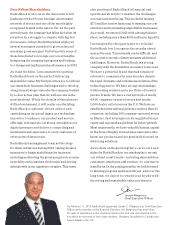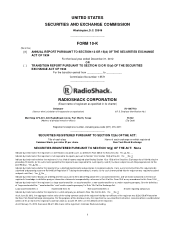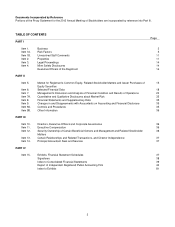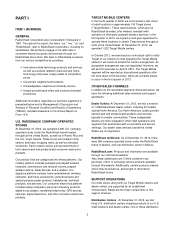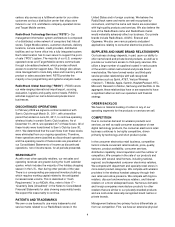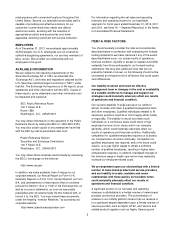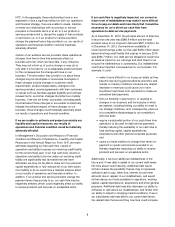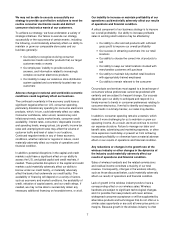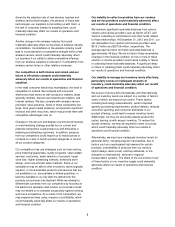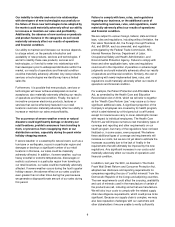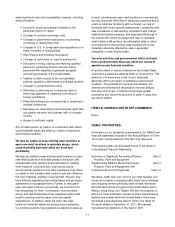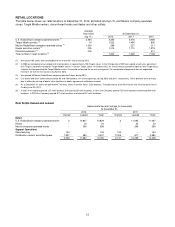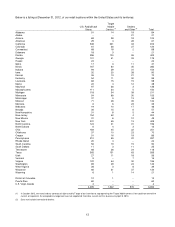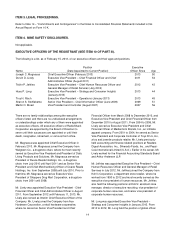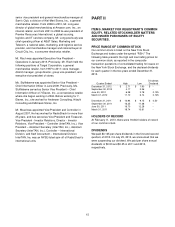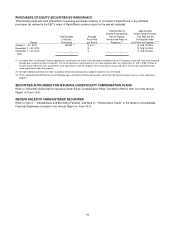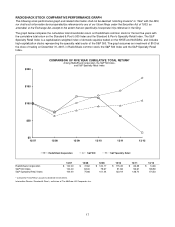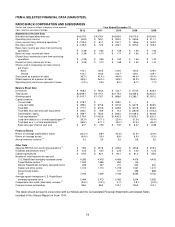Radio Shack 2012 Annual Report Download - page 10
Download and view the complete annual report
Please find page 10 of the 2012 Radio Shack annual report below. You can navigate through the pages in the report by either clicking on the pages listed below, or by using the keyword search tool below to find specific information within the annual report.8
driven by the adoption rate of new wireless handset and
wireless service technologies, the absence of these new
technologies, our suppliers not providing us with them, or
the lack of consumer interest in adopting them, could
materially adversely affect our results of operations and
financial condition.
Another change in the wireless industry that could
materially adversely affect our business is wireless industry
consolidation. Consolidation in the wireless industry could
lead to a concentration of competitive strength within a few
wireless carriers, which could materially adversely affect
our business if our ability to obtain competitive offerings
from our wireless suppliers is reduced or if competition from
wireless carrier stores or other retailers increases.
Our competition is both intense and varied, and our
failure to effectively compete could materially
adversely affect our results of operations and financial
condition.
In the retail consumer electronics marketplace, the level of
competition is intense. We compete with consumer
electronics retail stores as well as big-box retailers, large
specialty retailers, discount and warehouse retailers, and
Internet retailers. We also compete with wireless service
providers’ retail presence. Some of these competitors are
large, have great market presence, and possess significant
financial and other resources, which may provide them with
competitive advantages over us.
Changes in the amount and degree of promotional intensity
or merchandising strategy exerted by our current and
potential competitors could present us with difficulties in
retaining and attracting customers. In addition, pressure
from our competitors could require us to reduce prices or
increase our costs in certain product categories or across
all our product categories.
Our competitors may use strategies such as lower pricing,
price matching/guarantees, loyalty programs, value-added
services, exclusives, wider selection of products, larger
store size, higher advertising intensity, enhanced store
design, and more efficient sales methods. Some of our
competitors may be able to offer innovative, technologically
superior, or more desirable products and services that are
not available to us, are available in limited quantities, or
become available to us only after the demand for the
products and services has declined. While we attempt to
differentiate ourselves from our competitors by focusing on
the electronics specialty retail market, our business model
may not enable us to compete successfully against existing
and future competitors. As a result of this competition, we
may experience lower sales, margins or profitability, which
could materially adversely affect our results of operations
and financial condition.
Our inability to collect receivables from our vendors
and service providers could materially adversely affect
our results of operations and financial condition.
We maintain significant receivable balances from various
vendors and service providers such as Sprint, AT&T, and
Verizon consisting of commissions and other funds related
to these relationships. At December 31, 2012 and 2011, our
net receivables from vendors and service providers were
$315.3 million and $273.8 million, respectively. The
average payment term for these receivable balances is
approximately 45 days. We do not factor these receivables.
Changes in the financial condition of one or more of these
vendors or service providers could cause a delay or failure
in collecting these receivable balances. A significant delay
or failure in collecting them could materially adversely affect
our results of operations and financial condition.
Our inability to manage our inventory levels effectively,
particularly excess or inadequate amounts of
inventory, could materially adversely affect our results
of operations and financial condition.
We source inventory both domestically and internationally,
and our inventory levels are subject to a number of factors,
some of which are beyond our control. These factors,
including technology advancements, vendor-imposed
quantity purchasing requirements, product defects, reduced
consumer spending and consumer disinterest in our
product offerings, could lead to excess inventory levels.
Additionally, we may not accurately assess product life
cycles, leaving us with excess inventory. To reduce this
excess inventory, we may be required to lower our prices,
which could materially adversely affect our results of
operations and financial condition.
Alternatively, we may have inadequate inventory levels for
particular items, including popular merchandise, due to
factors such as unanticipated high demand for certain
products, unavailability of products from our vendors,
import delays, labor unrest, untimely deliveries, or the
disruption of international, national or regional
transportation systems. The effect of the occurrence of any
of these factors on our inventory supply could materially
adversely affect our results of operations and financial
condition.


